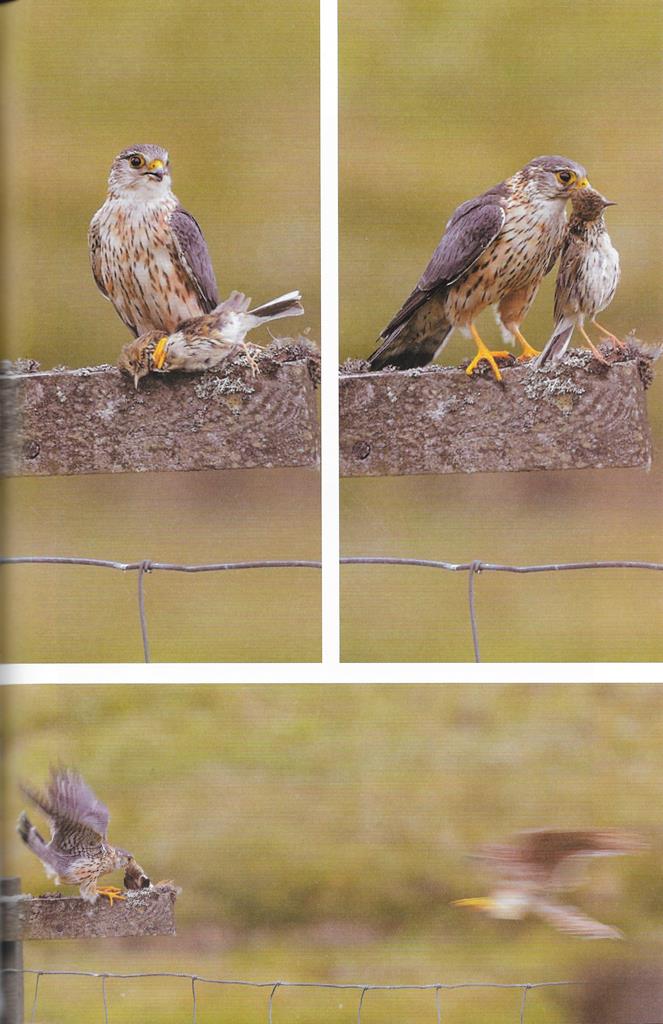Reviewed by Grant McCreary on October 20th, 2015.
When I think falcon, I think Peregrine. The next to come to mind would be the colorful American Kestrel, always a treat to see on a wire or hovering over a field. Then is the Gyrfalcon, one of the birds I most want to see. Occurring last, perhaps even not at all, is the Merlin. But it’s not just me, the ornithological literature also seems to neglect this poor bird. But Richard Sale has helped to rectify that with this monograph The Merlin.
Sale first takes a look at falcons as a whole, covering some general characteristics. This overview starts with taxonomy within the Falco family, which seems a little odd at first. But it becomes clear why when you get to the end of the species groups and find that the Merlin wasn’t included in any of them. That’s because “Merlins share characteristics with the Hobbies and the Peregrines, but are distinct from both.” Perhaps Merlins are more interesting than I gave them credit for?
As Sale proceeds to describe what is known about the Merlin, I find that is indeed the case. The Merlin covers every aspect of the bird’s natural history, including diet, hunting strategies, food consumption and energy balance, breeding (everything from territory to nest to eggs to fledging young), movements and winter grounds, survival, friends and foes, and population.
The Merlin is intended primarily for ornithologists and serious bird students. As such, it includes lots of charts and graphs visualizing the results of intensive studies and blocks of text that, as a non-ornithologist, I glazed over, frankly. But that’s not to say that the average birder won’t get anything out of reading this monograph. On the contrary, I discovered all kinds of interesting things. Here are a few…
I had always assumed that Merlins earned their old name of Pigeon Hawk because they preyed on pigeons. The truth is that this, as the author puts it, “natural assumption” is wrong; Merlins rarely take prey that large. Instead, “the name is actually from the similarity of the Merlin to a pigeon in size and flight pattern.” I guess that shouldn’t be too unexpected, given how falcon-like pigeons are in flight. Much more surprising is that Merlins have been observed mimicking the flight pattern of their prey in order to get close without arousing suspicion. Sale mentions several instances where a Merlin was reported to fly like a swallow while in the vicinity of a flock of those birds. In each case it was able to successfully pick off a swallow.
The Hunting Strategies chapter is especially fascinating. It summarizes several studies that calculated this falcon’s flight speed, including the author’s own effort to determine it based on photos he took of a male “handing off” food to his mate. The female swooped in and retrieved the proffered meal from her perched mate, all on the wing. The actions of the Merlin pair are interesting in and of themselves, but even better are the photos (three in the sequence are included, see below) and how the author was able to calculate the female’s speed based on references in the photos. It seems she was going 31.7-36.4 km/hr. Sale explains: “The speed does not seem high until one remembers that the female is taking prey from the male’s bill without either hauling him off the post or knocking him off with her wing: it was, in fact, a beautifully executed, high-speed manoeuvre.”

A female Merlin swoops in to take food from her mate.
A surprise to me: Skylarks sing as a predator deterrent! Apparently, some Skylarks will break into song when pursued by a Merlin, even in the midst of winter. The theory is that this will signal to the raptor that the bird has energy to spare and can risk doing something that would seemingly make capture even more likely. Amazingly, this strategy seems to work! Sale presents the results of a study that show Merlins will pursue singing birds for a shorter time and the capture rate of a singing bird is substantially lower than Skylarks that don’t sing.
That’s just really cool! But there are some interesting discoveries to be found even in more prosaic research. There is a reason for everything that birds do, many of which we birders don’t normally think about. One such thing is the timing of egg laying. Ornithologists have found that Merlins lay their eggs so that their young are fledging when the small birds that they prey upon are also fledging their young. The new Merlins, learning how to hunt, preferentially target this easier prey.
Even though you will learn many exciting things about Merlins, don’t expect the text to be equally stimulating. The author does what he can to spice up writing meant for professional audiences, but there’s only so much that one can do when reporting studies and observations. Every now and then, though, there’s a nice little surprise, such as this tidbit found in a list of prey items of some urban Merlins: “…and, very unfortunately for the little bird doubtless both enjoying, but daunted by, its probably all-too-brief freedom, a Budgerigar”.
This monograph includes many nice color photographs of Merlins across their range, engaged in various behaviors. Some habitat photos complement them, a nice touch. No one is going to buy this book just for the pictures, but it does contain a good selection.
I rarely mention the cover art and design of books, but have to in this case. The solid block of color on the book’s jacket isn’t very attractive and the choice of a fledgling Merlin for the front cover is baffling. There are any number of photos in the book which would have been better suited. Or, even easier, just switch it with the large photo of a Merlin with prey adorning the back cover. The old adage of not judging a book by its cover is definitely applicable here.
Recommendation
Sorry, Merlins, I was remiss to neglect you. The Merlin reveals a fascinating bird, as well as an interesting look at the studies that have shed light on it. It is required for anyone working with this falcon, and recommended to other ornithologists, as well as birders and falconers who’d like to know more about it.
Disclosure: I get a small commission for purchases made through links in this post.
Buy from NHBS
(based in the U.K.)
Disclosure: The item reviewed here was a complementary review copy provided by the publisher. But the opinion expressed here is my own, it has not been influenced in any way.






[…] The Birder’s Library […]